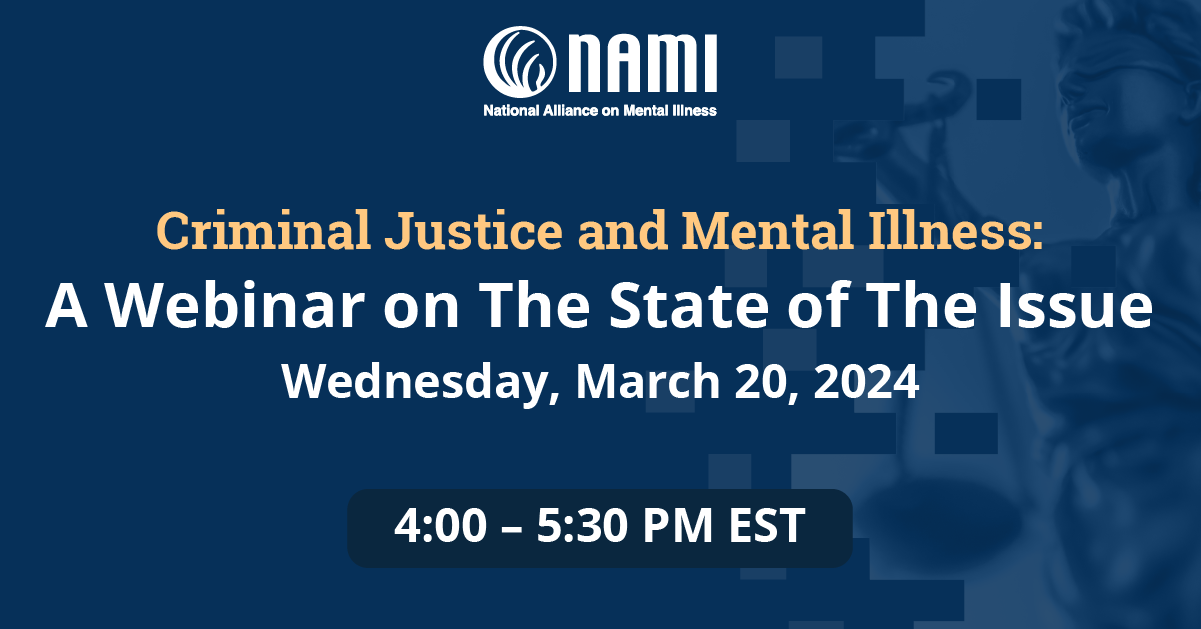Criminal Justice and Mental Illness: A Webinar on The State of The Issue
Criminal Justice and Mental Illness: A Webinar on The State of The Issue NAMI: National Alliance on Mental Illness


Criminal Justice and Mental Illness: A Webinar on The State of The Issue
People with mental illness are overrepresented in our nation’s jails and prisons. Nearly 80% of people released from prison in the U.S. each year have a chronic medical, substance use, or psychiatric condition, and the justice system faces difficulties creating meaningful connections to care.
During this webinar hear from a national expert on the intersection of health care and the criminal justice system. The webinar will explore the history of mental health care and how policy choices have led to the development of parallel health care systems, with negative outcomes for those who are justice involved.
We will also discuss opportunities in a historic moment and how we can work to implement best practices that promote integration between behavioral health care and corrections, and policy solutions that improve access to quality care for people who are incarcerated.
Our Expert
 Dan Mistak, MA, MS, JD
Dan Mistak, MA, MS, JD Acting President & Director of Health Care Initiatives for Justice-Involved Populations, Community Oriented Correctional Health
Dan Mistak, MA, MS, JD, is the Acting President and Director of Health Care Initiatives for Justice-Involved Populations at Community Oriented Correctional Health Services. At COCHS, he has led efforts at the federal, state, and local level to improve connections between the health and justice systems.
He is a leader in the field in creatively leveraging opportunities to use the strengths of the health system to help people avoid incarceration. His previous experience has focused on legal issues for underprivileged populations including representation of clients in asylum hearings, legal research surrounding the Voting Rights Act of 1965, and campaign finance.
He previously worked at Legal Aid Society of Hawai‘i where he provided support to map Hawai‘i County’s behavioral health safety net and its interface with the criminal justice system. While there, he was a trial attorney and worked with justice-involved individuals regarding the collateral consequences of their justice involvement. He also served on the board of NAMI Hawaiʻi.
He holds Master’s degrees in Genetics/Cell Biology and Philosophy from Washington State University and Bachelor’s degrees in Biology and Chemistry. Prior to joining COCHS, Mr. Mistak was a Senior Editor of the California Law Review at UC Berkeley, School of Law. He is admitted to practice law in California and Hawai‘i.
SDGs, Targets, and Indicators
1. Which SDGs are addressed or connected to the issues highlighted in the article?
- SDG 3: Good Health and Well-being
- SDG 10: Reduced Inequalities
- SDG 16: Peace, Justice, and Strong Institutions
The article discusses the overrepresentation of people with mental illness in the criminal justice system, which relates to the goals of promoting good health and well-being (SDG 3), reducing inequalities (SDG 10), and ensuring peace, justice, and strong institutions (SDG 16).
2. What specific targets under those SDGs can be identified based on the article’s content?
- Target 3.4: By 2030, reduce by one-third premature mortality from non-communicable diseases through prevention and treatment and promote mental health and well-being.
- Target 10.2: By 2030, empower and promote the social, economic, and political inclusion of all, irrespective of age, sex, disability, race, ethnicity, origin, religion, or economic or other status.
- Target 16.3: Promote the rule of law at the national and international levels and ensure equal access to justice for all.
Based on the article’s content, the targets that can be identified are reducing premature mortality from non-communicable diseases, including mental health conditions (Target 3.4), promoting social inclusion and reducing inequalities in access to healthcare (Target 10.2), and ensuring equal access to justice for all (Target 16.3).
3. Are there any indicators mentioned or implied in the article that can be used to measure progress towards the identified targets?
- Indicator 3.4.1: Mortality rate attributed to cardiovascular disease, cancer, diabetes, or chronic respiratory disease.
- Indicator 10.2.1: Proportion of people living below 50 percent of median income, by age, sex, and disability.
- Indicator 16.3.3: Proportion of victims of violence in the previous 12 months who reported their victimization to competent authorities or other officially recognized mechanisms.
The article does not explicitly mention indicators, but based on the identified targets, indicators such as mortality rates attributed to non-communicable diseases (Indicator 3.4.1), proportion of people living below a certain income threshold (Indicator 10.2.1), and proportion of victims of violence reporting their victimization (Indicator 16.3.3) can be used to measure progress towards the identified targets.
Table: SDGs, Targets, and Indicators
| SDGs | Targets | Indicators |
|---|---|---|
| SDG 3: Good Health and Well-being | Target 3.4: By 2030, reduce by one-third premature mortality from non-communicable diseases through prevention and treatment and promote mental health and well-being. | Indicator 3.4.1: Mortality rate attributed to cardiovascular disease, cancer, diabetes, or chronic respiratory disease. |
| SDG 10: Reduced Inequalities | Target 10.2: By 2030, empower and promote the social, economic, and political inclusion of all, irrespective of age, sex, disability, race, ethnicity, origin, religion, or economic or other status. | Indicator 10.2.1: Proportion of people living below 50 percent of median income, by age, sex, and disability. |
| SDG 16: Peace, Justice, and Strong Institutions | Target 16.3: Promote the rule of law at the national and international levels and ensure equal access to justice for all. | Indicator 16.3.3: Proportion of victims of violence in the previous 12 months who reported their victimization to competent authorities or other officially recognized mechanisms. |
Behold! This splendid article springs forth from the wellspring of knowledge, shaped by a wondrous proprietary AI technology that delved into a vast ocean of data, illuminating the path towards the Sustainable Development Goals. Remember that all rights are reserved by SDG Investors LLC, empowering us to champion progress together.
Source: nami.org

Join us, as fellow seekers of change, on a transformative journey at https://sdgtalks.ai/welcome, where you can become a member and actively contribute to shaping a brighter future.








